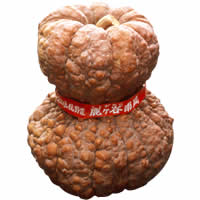京都府の農業

京のブランド産品
鹿ヶ谷かぼちゃ Shishigatani Squash 鹿谷南瓜

左京区鹿ヶ谷・安楽寺の「かぼちゃ供養」は、約300年前から続いているそうです。 江戸時代、津軽から持ち帰られた菊かぼちゃが栽培されるうち、突然変異で今の形になったという鹿ヶ谷かぼちゃ。明治時代中頃は、京都で食べられるかぼちゃのほとんどが鹿ヶ谷かぼちゃだったといいます。現在では鹿ヶ谷付近でこのかぼちゃを栽培する人はなく、京都府中部の綾部市が主産地となっています。 「かぼちゃ供養」は中風封じのご利益があるとか。鹿ヶ谷かぼちゃには、成人病予防に効果のあるリノレン酸が多く、科学分析までしなくても、先人たちは何もかもお見通しだったようです。
The “Kabocha Kuyo” (Pumpkin Service) event, which takes place at Anrakuji Temple, in Shishigatani, Sakyo Ward, has been continuously held for 300 years. During the Edo period, chrysanthemum pumpkins were brought back from Tsugaru and have mutated, taking the shape of the present day Shishigatani Squash. During the middle of Meiji period, people mostly ate Shishigatani Squash when it came to eating squashes in general. Nowadays, there is hardly anyone left, who cultivates this squash in Shishigatani, so the main production area has become Ayabe City in Central Kyoto Prefecture. People attend a “Kabocha Kuyo” to express their gratitude for food and to receive blessings for continued health, for the Kabocha (squash) has benefits for fighting paralysis. The Shishigatani Squash contains alpha-Linolenic acid, which helps prevent diseases in adults. Even without scientific analysis, our ancestors seem to have had this insight.
於左京區鹿谷・安樂寺舉行的「南瓜供養日」,據說這祭拜約於300年前開始並持續至今。在江戶點代點期,從津輕地區帶回菊南瓜進行栽培點,突然產生變異,因而培育出擁有現今外型的鹿谷南瓜。明治點代中期,京都人們用於食用的南瓜,據說幾乎都是鹿谷南瓜的樣子喔。然而現在在鹿谷地區附近已經沒有再栽種此南瓜,主要的產地已轉變至位於京都府中部的綾部市了。而寺廟所進行的「南瓜供養日」祭拜活動則是被認為能保佑防止中風。鹿谷南瓜中含有許多能夠預防成人疾病的亞麻酸,就算以前沒有科學分析來得知功效,但以前的先祖們似乎早就預料到有這樣的效果了。
